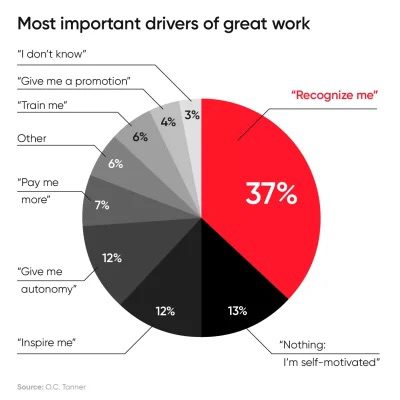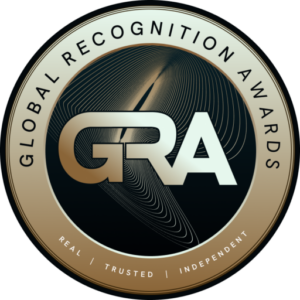Employee Recognition: What It Is, Why It Matters, and How to Get It Right
- Kris Gia Escueta
Table of Contents
Ever put in extra effort at work, expecting at least a nod of appreciation, only to be met with silence? It’s deflating, right?
Now, picture the opposite—a workplace where achievements, big and small, are noticed, valued, and celebrated. That’s the power of employee recognition, and it plays a massive role in creating an engaged, motivated workforce.
Employee recognition isn’t just a nice-to-have perk; it’s a necessity in any successful workplace. When employees feel appreciated, they’re more engaged, productive, and loyal.
Research backs this up: a 2023 State of Recognition Report by Achievers found that employees recognized monthly are 36% more likely to report high productivity and engagement and 22% more likely to be highly committed to their roles compared to those recognized quarterly.
This means that recognizing employees regularly is a direct investment in business success.
This article explores what employee recognition in the workplace really means, why it’s essential, and how organizations can get it right.
We’ll break down different types of workplace recognition, from spontaneous shoutouts to structured programs. Plus, we’ll cover what makes recognition meaningful and the common mistakes companies make when trying to implement it.
By the end, you’ll have a clear roadmap for fostering a culture of staff recognition that benefits both employees and the business.
Because let’s be real, everyone wants to be seen, valued, and appreciated. And when that happens, the workplace becomes a better place for all.
Nominate Outstanding Employees Today
Show appreciation where it counts! Submit your nomination and celebrate excellence.
What is Employee Recognition?
Employee recognition is the act of appreciating and acknowledging an employee’s contributions, efforts, or achievements in the workplace. It’s a simple but powerful way to reinforce positive behavior, boost morale, and strengthen an organization’s culture.
Whether it’s a quick “great job” in a meeting or a structured awards program, recognition shows employees they are valued.
Recognition vs. Rewards: What’s the Difference?
While the terms are often used interchangeably, recognition and rewards serve different purposes. Recognition is about appreciation—it’s the verbal praise, handwritten note, or company-wide shoutout that lets employees know their efforts matter. Rewards, on the other hand, are tangible incentives like bonuses, gift cards, or extra time off.
A well-balanced workplace recognition strategy incorporates both. However, research shows that meaningful recognition—especially when personalized—has a stronger long-term impact on employee engagement than monetary rewards alone.
Why Employee Recognition Shapes Workplace Culture
Employee recognition has a direct impact on workplace culture. When employees know their efforts are valued, they stay motivated, work well with others, and are more likely to stay with the company.
A culture of appreciation also reinforces company values. If teamwork, innovation, or customer service are priorities, recognizing employees who demonstrate these qualities helps create an environment where they continue to grow.
A recent survey from the Global Recognition Awards in January 2024 supports this idea. It found that 83% of employees feel more motivated when their employer publicly acknowledges their contributions.
The survey gathered responses from HR professionals, managers, and employees across industries such as technology, healthcare, and finance, exploring their views on workplace recognition.
On the other hand, employees who feel overlooked may lose motivation and become frustrated, which can hurt productivity and increase turnover.
Lack of recognition can also weaken team morale and make employees feel disconnected. Creating a culture where achievements are regularly acknowledged helps maintain engagement and strengthens overall workplace performance.

Why Does Employee Recognition Matter?
Working hard on a project and receiving no acknowledgment can be frustrating. Unfortunately, this happens often, and the consequences are serious.
A 2024 Gallup survey found that employees who receive regular recognition and praise are 2.5 times more likely to be happy with their jobs and 1.5 times more likely to feel motivated to do their best.
Employee recognition strengthens engagement, reduces turnover, and improves workplace culture.
Motivation and Engagement
Employees bring more energy and effort to their roles when they feel appreciated. Recognition fuels motivation and keeps employees engaged.
Psychologists have long emphasized the importance of recognition. Maslow’s Hierarchy of Needs places esteem, including appreciation, as a fundamental human requirement. Herzberg’s Two-Factor Theory identifies recognition as a major driver of job satisfaction.
For example, a sales associate who consistently exceeds targets may lose motivation if leadership ignores their success.
A simple acknowledgment, whether in a company meeting or through a direct message from leadership, can reinforce their dedication.
Job Satisfaction and Retention
Many employees leave their jobs because they feel unappreciated. Studies show that a lack of recognition is one of the top reasons for turnover.
High turnover costs businesses thousands of dollars per lost employee, making it essential to create a workplace where employees feel valued.
Gallup’s research highlights the importance of appreciation. Employees who feel recognized report higher job satisfaction and a stronger commitment to their organizations.
Companies like Salesforce have implemented structured recognition programs that have helped them retain talent and build loyalty.
Pro Tip: Public acknowledgment of contributions can strengthen employees’ connection to the company and its mission.
Workplace Culture and Team Morale
A strong workplace culture grows when employees feel valued. Acknowledgment encourages teamwork and a positive work environment.
Peer-to-peer recognition programs make a difference. Encouraging employees to recognize each other’s contributions strengthens team bonds and raises morale.
A Slack message, a quick thank-you during a meeting, or an Employee of the Month program all help create a culture of appreciation.
What Happens When Employees Don’t Feel Recognized?
A lack of recognition leads to disengagement, frustration, and increased turnover. Employees who feel overlooked may stop putting in extra effort or begin searching for other job opportunities. Recognition fosters commitment, while neglecting it creates disinterest and dissatisfaction.
How to Reward Employees Effectively
Recognizing employees should be timely, meaningful, and consistent. How to reward employees effectively depends on their preferences and the workplace environment.
Here are some ideas for effective workplace recognition:
- Public Praise: Acknowledgment during company meetings or on social media.
- Private Appreciation: A thoughtful email or a one-on-one thank-you.
- Incentives & Perks: Extra time off, professional development opportunities, or career advancement options.
Feeling valued motivates employees to do their best. Creating a culture of recognition helps businesses retain talent and build a more engaged workforce.

Source: Vega HR
The graph shows that employee recognition is the most significant driver of great work, surpassing financial incentives and autonomy. This emphasizes the need for organizations to prioritize appreciation to enhance motivation and performance.
Types of Employee Recognition
There’s no one-size-fits-all approach to employee recognition. Some people love the spotlight, while others prefer a quiet “thank you” over coffee.
Whether through formal awards, casual shoutouts, or financial incentives, workplace recognition plays a critical role in keeping employees engaged and motivated. Let’s explore the different ways businesses can foster a culture of appreciation.
Peer-to-Peer Recognition
Recognition doesn’t have to come from the top down. Sometimes, the best appreciation comes from colleagues who witness the hard work firsthand.
Peer-to-peer recognition encourages employees to celebrate each other’s contributions, creating a more connected and supportive workplace.
Many companies use “kudos boards,” where employees leave public notes of appreciation for their peers. Digital alternatives include Slack or Microsoft Teams shoutouts, where a simple emoji reaction or message can boost morale instantly.
Managerial Recognition
While peer recognition is powerful, being recognized at work by a manager carries its own weight. Employees look to leadership for validation, and a well-timed acknowledgment from a boss can reinforce positive behaviors and performance.
Managers can make a real impact by personalizing their recognition. Instead of a generic “great job,” a meaningful approach could be:
“Jane, your problem-solving on the client issue saved us a major headache. Your quick thinking and dedication didn’t go unnoticed!”
Even better, recognizing employees in one-on-one meetings can provide a private moment of appreciation that feels genuine.
Pro Tip: Managers should make recognition part of regular check-ins to ensure it becomes a habit.
Formal Recognition Programs: Structured and Impactful
For organizations looking to make recognition systematic, employee recognition awards and structured programs are effective ways to acknowledge hard work. These initiatives often include:
- “Employee of the Month” Awards: Publicly celebrating standout performance.
- Long-Service Awards: Recognizing employees for their commitment over the years.
- Performance-Based Bonuses: Financial incentives tied to exceptional work.
Such programs provide clear expectations and ensure no employee’s contributions go unnoticed. However, they should be complemented with ongoing appreciation to avoid feeling transactional.
Informal Recognition
Not all recognition needs to be official. Sometimes, the smallest gestures have the biggest impact. A quick “thank you” email, a handwritten note, or a company-wide Slack message can make someone’s day.
For example, some CEOs handwrite personal thank-you notes to employees who go above and beyond. A simple “Hey, I saw how you handled that client issue. Amazing work!” can go a long way in fostering loyalty and motivation.
Monetary vs. Non-Monetary Recognition
Many companies believe that recognition equals financial rewards, but that’s only part of the picture. While bonuses and raises are great, employees also appreciate non-monetary recognition, such as:
- Extra paid time off.
- Career development opportunities, like attending a conference.
- Flexible work arrangements.
Studies show that while monetary rewards are motivating, non-monetary forms of recognition—like professional growth and work-life balance—often lead to longer-lasting engagement.
Public vs. Private Recognition
Some employees thrive on public recognition, while others prefer a more personal approach. Understanding individual preferences ensures that staff recognition feels meaningful rather than awkward.
- Public Recognition: Social media shoutouts, company newsletters, or awards at meetings.
- Private Recognition: One-on-one praise, personal thank-you notes, or a quiet nod of appreciation.
A good rule of thumb? If an employee loves the stage, celebrate them in front of the team. If they’re more reserved, a thoughtful private message might mean more.
Also Read: How to Get Recognized in Your Industry
Celebrate Outstanding Employees
Nominate your top performers today and give them the recognition they deserve.
What Makes an Effective Employee Recognition Program?
Building an employee recognition program isn’t about handing out the occasional “Good Job!” sticker. It’s about creating a structured, meaningful system that makes employees feel valued in a way that resonates with them.
A well-designed program can boost morale, improve retention, and even make your company more attractive to top talent.
But what separates a forgettable recognition initiative from one that genuinely motivates and inspires? Let’s break it down.
1. Personalization
Imagine two employees: One loves public shoutouts during company meetings, while the other prefers a private email acknowledging their hard work. Recognition should be tailored to individual preferences.
Employees are more likely to feel genuinely appreciated when recognition aligns with their personality and values.
A study by Gallup found that employees who feel personally recognized are three times more likely to be engaged at work. That’s a strong case for making recognition personal!
2. Timeliness
Recognition loses impact when delayed. Think about it: if someone congratulated you for an achievement you made six months ago, would it carry the same weight? Probably not.
Timely recognition reinforces the connection between the action and the appreciation, making it more meaningful.
It also encourages employees to continue high-performance behaviors, knowing their efforts will be acknowledged promptly.
3. Consistency
A common mistake companies make is treating recognition as a one-time event rather than an ongoing practice. Employees should feel valued year-round—not just during an annual awards ceremony.
Consider implementing regular touchpoints, such as:
- Weekly or monthly appreciation emails from leadership.
- A standing “Recognition Moment” during team meetings.
- Peer-to-peer shoutout platforms where employees can highlight colleagues’ contributions.
The more consistent the recognition, the more ingrained it becomes in your company culture.
4. Transparency and Fairness
Recognition can backfire if it feels biased or unclear. Employees need to understand how and why recognition is given. Otherwise, it can lead to resentment rather than motivation.
To maintain fairness:
- Clearly outline recognition criteria.
- Ensure all departments and levels of employees are included.
- Gather feedback to refine the program over time.
When recognition is transparent and equitable, it fosters trust and strengthens workplace relationships.
5. Aligning Recognition with Company Values and Goals
Recognition should reinforce the behaviors and values that drive your business forward. If teamwork is a core company value, recognize employees who collaborate effectively. If innovation is key, highlight those who bring new ideas to the table.
Aligning recognition with business objectives can create a culture where appreciation fuels performance.
6. The Power of External Recognition
While internal recognition is crucial, sometimes it pays to go bigger. External recognition, like Global Recognition Awards, can elevate your program by showing employees that their contributions matter on an industry-wide level.
Being recognized outside the company can:
- Boost employee pride and morale.
- Enhance employer branding and attract top talent.
- Encourage a culture of striving for excellence.
For example, companies that nominate employees for external awards often see an increase in engagement and motivation. Employees feel like their work is acknowledged internally and celebrated at a higher level.
The Benefits of Employee Recognition
Employee recognition is a workplace superpower that can transform morale, boost productivity, and even improve a company’s bottom line.
When people feel seen and valued, they don’t just show up for work; they show up engaged, motivated, and ready to give their best. Let’s break down why employee recognition in the workplace is a game-changer.
1. Happier Employees, Stronger Morale
Being recognized at work is about feeling valued and appreciated. Employees who receive regular recognition report higher job satisfaction, leading to a more positive and energized work environment.
Whether it’s a simple “thank you” from a manager or a peer-to-peer shoutout, workplace recognition fuels motivation and keeps morale high.
2. Lower Turnover, Higher Retention
A lack of recognition is one of the fastest ways to send employees running for the exit. Studies show that organizations with effective recognition programs experience 31% lower turnover rates—a massive advantage in today’s competitive job market.
When staff recognition is woven into company culture, employees stick around longer, build stronger team bonds, and remain committed to company success.
3. Higher Productivity
Want employees to go the extra mile? Start recognizing their efforts. Recognition at work has been directly linked to increased productivity, as employees are more likely to engage deeply with their tasks when they know their contributions matter.
Whether it’s acknowledging a project well done or celebrating milestones, regular employee recognition encourages high performance and sustained effort.
4. Stronger Workplace Relationships
Recognition strengthens team dynamics, too. When appreciation is part of workplace culture, employees build mutual respect, trust, and camaraderie.
Peer-to-peer recognition, in particular, creates an environment where everyone feels valued, fostering a supportive and collaborative atmosphere.
5. Attracting Top Talent
Want to attract high-performing professionals? A strong recognition culture can help. Talented employees seek workplaces where their contributions will be recognized.
Organizations that prioritize staff recognition, whether through structured programs or spontaneous praise, gain a reputation as employers of choice, making it easier to attract and retain top talent.
6. Business Growth
Beyond employee happiness, recognition has a direct impact on a company’s success. Studies show that organizations with strong recognition practices experience higher levels of profitability, innovation, and overall performance. When employees are engaged and motivated, the entire business benefits.
7. Global Recognition for Bigger Impact
While internal recognition is powerful, companies can take it a step further with global recognition through prestigious awards. Industry-wide acknowledgments validate employee achievements and inspire the entire workforce to strive for excellence.
Whether it’s company-wide honors or individual accolades, external recognition reinforces a culture of appreciation and ambition.

Common Mistakes to Avoid in Employee Recognition
Even the best intentions can go wrong. Employee recognition is a powerful tool, but when mismanaged, it loses its impact. If you’ve ever handed out “Employee of the Month” awards and noticed more eye-rolls than enthusiasm, you might be making one of these common mistakes.
Mistake #1: Giving Empty Praise
Telling someone they’re doing a “great job” without specifics is like serving a birthday cake with no candles—technically correct but missing the spark. Employees need meaningful feedback to feel valued. Instead of a vague “thanks for your hard work,” try:
“Your leadership on the project helped us meet the deadline ahead of schedule. We couldn’t have done it without your initiative!”
When recognition is specific and authentic, employees see that their contributions truly matter.
Mistake #2: Recognizing Employees Only Occasionally
Workplace recognition shouldn’t be reserved for annual reviews or once-a-year bonuses. Sporadic appreciation can make employees feel like their work goes unnoticed most of the time.
If recognition only happens when someone resigns or hits a 10-year milestone, it’s not appreciation—it’s damage control.
Instead, build recognition into everyday interactions. A quick shoutout in a meeting or a personal note can have a lasting impact.
Mistake #3: Ignoring Individual Preferences
Not everyone loves the spotlight. Some employees enjoy public praise, while others prefer a quiet “thank you” in private.
A one-size-fits-all approach to recognition can make some employees uncomfortable rather than appreciated.
A good rule of thumb: Ask your employees what type of recognition they value. Some might appreciate a social media post celebrating their success, while others may prefer a handwritten note or a lunch with leadership.
Pro Tip: Ask employees how they prefer to be recognized and tailor your approach accordingly.
Mistake #4: Treating Money as the Only Motivator
Bonuses and raises are great, but financial rewards alone don’t foster long-term motivation. If your only recognition strategy is tied to money, you might create a transactional work environment where employees feel valued for what they do—not for who they are.
Consider non-monetary recognition like:
- A personalized thank-you message from leadership.
- Flexible work options or additional time off.
- Professional growth opportunities, such as industry conferences or mentorship programs.
When employees feel appreciated beyond their paycheck, they develop a stronger emotional connection to their work.
Mistake #5: Forgetting the Bigger Picture
Employee recognition should align with company values and goals. If your organization claims to prioritize innovation but only rewards employees for hitting sales targets, there’s a disconnect. The best recognition programs reflect what the company stands for.
External recognition can also reinforce an appreciation culture. Programs like entrepreneur awards celebrate outstanding contributions on a larger stage, inspiring employees to strive for excellence.
Make Employee Recognition Meaningful
Employee recognition keeps a workplace strong. When people feel valued, they stay engaged, work harder, and contribute more. A simple “great job” or a structured recognition program can boost motivation and strengthen teams.
If recognition feels like an afterthought, it may be time to change things up. The most effective programs are consistent, personal, and timely.
Internal praise makes a difference, but external recognition, like the Global Recognition Awards, adds another layer by highlighting achievements on a bigger scale.
A workplace that values its employees creates long-term success. Ready to improve your employee recognition strategy? Apply today.

Jethro Sparks
Founder of Global Recognition Awards
Related posts
Ready to take your business to the next level?
Apply today and be a winner




